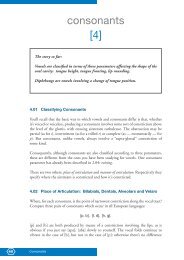PHONETICS MANUAL.indd - HumBox
PHONETICS MANUAL.indd - HumBox
PHONETICS MANUAL.indd - HumBox
Create successful ePaper yourself
Turn your PDF publications into a flip-book with our unique Google optimized e-Paper software.
Vowels<br />
[3]<br />
The story so far:<br />
Speech sounds are produced (articulated) by placing an obstacle of some kind in<br />
the path of air passing through the laryngeal, pharyngeal and/or oral cavities.<br />
3.01 Tongue Position for Vowels<br />
There are a huge number of different vowel sounds in the languages of the world,<br />
and, as will be seen in a moment, one of the jobs of phonetics is impose order on<br />
chaos by providing a way of describing them coherently and concisely. But whatever<br />
their differences, all vowels involve free passage of lung air through the upper vocal<br />
tract. (This is what distinguishes them from consonants, for which, as you began<br />
to see in the last chapter, there is always some obstruction above the level of the<br />
larynx). The impediment to the airstream for vowels is located at the glottis, not<br />
in the supra-glottal tract: the vocal folds are in close enough contact for vibration<br />
to occur. The sound wave that this generates is amplified by the resonance of the<br />
cavities above the larynx.<br />
This means that vowels are normally voiced: “normally” because voiceless vowels<br />
are a possibility — they can best be thought of as whispered vowels. Although the<br />
vocal folds aren’t actually vibrating for these, there’s still sufficient constriction at the<br />
glottis for the airstream to be impeded and for turbulence (i.e. a sound wave) to be<br />
generated — you can feel this constriction if you say a few vowels in as loud a whisper<br />
as you can.<br />
Quite a few languages (Portuguese is a well-known example) have voiceless or<br />
whispered vowels in unstressed syllables. (They aren’t sonorous enough to be much<br />
use in stressed syllables). Voiceless vowels are even possible in English in words like<br />
police or polite: here the stress is on the last syllable, so the o in the first syllable,<br />
instead of being fully voiced, may, with some speakers, be devoiced as a preliminary<br />
to disappearing altogether: p’lice, p’lite.<br />
Now, although the air passes freely through the vocal tract, the shape of the tract varies<br />
from one vowel to another according to the position taken up by the tongue. (But it<br />
never gets so constricted that the airstream is slowed down or blocked.)<br />
Figures 7, 8, 9 and 11 below are from tracings of X-ray photographs taken while<br />
the vowel sound of the word in question was being uttered, so they give a true<br />
14 Vowels






